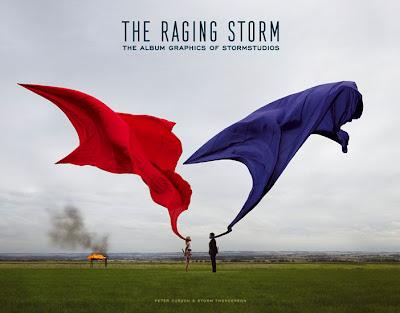
La fotografia dell’impossibile da: Musica per immagini, Immagini per la musica Quando, a fine anni 60, Storm Thorgerson e Aubrey Powell fondarono lo studio fotografico Hipgnosis derivandone il nome da “hip” (alla moda) "gnosis” (antico movimento filosofico medio-orientale) sembrava l’ennesima futile trovata pseudo-hippy. In realtà, da allora, la storia del “Classic Rock” non sarebbe più stata la stessa. Legando il suo nome a quello di tutti i massimi complessi dell’epoca, dai Pink Floyd ai Led Zeppelin, dai Genesis a Emerson, Lake & Palmer, Thorgerson proiettò il design-rock in un ambito di professionalità ed esattezza formale ancora sconosciuto. Se fino ad allora i grandi capolavori erano limitati a collaborazioni indissolubili (Dean-Yes) o ad ambienti geografico-sociali ristretti (la California del Fillmore e Robert Crumb), la Hipgnosis trovò il metodo per ricostruire un intero LP per immagini, qualunque fosse la musica, chiunque fosse l’autore: un lavoro di sintesi che portava ad isolare pochi concetti o forme chiave che diventavano il volano per rappresentazioni figurative tra le più potenti della musica commerciale contemporanea. Un metodo rigoroso e applicabile in modo estensivo. Thorgerson e Powell erano essenzialmente fotografi e l’immagine fotografica è la base di ogni loro lavoro: un’immagine pulita e nitida che viene però decontestualizzata e rimontata in sfondi inconsueti e cromaticamente sconvolgenti: in parte surrealismo, in parte documentario di eventi improbabili, in parte semplice gusto per la saturazione del colore e lo slittamento della scala cromatica. Un lavoro di fotoritocco e fotomontaggio totalmente “analogico”; Photoshop prima del computer. E se da un lato è la manipolazione dell’immagine su pellicola la chiave del successo di Thorgerson e soci, dall’altro non manca una propulsione creativa che spesso si spinge ad alterare la realtà con installazioni artistiche memori, su piccola scala, degli esperimenti di Christo e della Land Art. Capaci di interagire attivamente coi complessi (per esempio con gli amici Pink Floyd) come di costruire dal nulla veri e propri packaging che sono “concept per immagini”, i creativi della Hipgnosis attraversarono gli anni ’70 producendo decine di cover-art, tutte immediatamente riconoscibili al punto che, nei primi anni ’80 parve formarsi una vera e propria “scuola” derivata dal lavoro di Storm Thorgerson. Dal canto suo la Hipgnosis si sciolse formalmente nel 1983, lasciando libero il leader Thorgerson di continuare a lavorare in autonomia per alcuni dei maggiori (e dei migliori) gruppi Rock degli ultimi 20 anni.
 When, in late 60's, Storm Thorgerson and Aubrey Powell founded the photography studio “Hipgnosis” assuming the name from "hip" and "gnosis" (an ancient Middle Eastern philosophical movement) it seemed yet another futile pseudo-hippie stuff. Actually, since then, the story of "Classic Rock" would not have been the same.
Linking his name with that of all major bands of the decade, from Pink Floyd to Led Zeppelin, from Genesis to Emerson, Lake & Palmer, Thorgerson projected the rock-design in an unknown sphere of professionalism and formal accuracy. Until then, the great masterpieces were limited to indissoluble collaborations (Dean-Yes) or restricted social-geographic environments (California's Fillmore and Robert Crumb); the Hipgnosis found the method to reconstruct an entire LP by images, whatever was the music, whoever was the author: a work of synthesis that led to isolate a few “key concepts” or geometrical forms that became the driving force for pictorial representations among the most powerful of contemporary commercial music. A rigorous method, applied extensively.
Thorgerson and Powell were essentially photographers and the photographic image is the basis for all their works: a clean and clear image that is decontextualized and reassembled on unusual and color-shocking backgrounds: in part surrealism, in part documentary of improbable events, in part simple taste for color saturation, and slipping of the chromatic scale. A work of editing and montage totally "analogic" Photoshop before the computer.
And while it is the manipulation of the image the key to the success of Thorgerson and Co., it does not lack a creative drive that often goes on to alter reality with art installations mindful, small-scale, of Christo and Land Art experiments. Able to actively interact with the bands (for example with friends Pink Floyd) as well to build from nothing packagings that are real "photo-concept", the creatives of Hipgnosis crossed the '70s producing tens of cover-art, all immediately recognizable to the point that, in the early '80s, seemed to form a real "school" derived from Storm Thorgerson’s works.
For its part, Hipgnosis formally disbanded in 1983, leaving the leader free to continue working for some of the biggest (and best) rock groups of the last 20 years.
When, in late 60's, Storm Thorgerson and Aubrey Powell founded the photography studio “Hipgnosis” assuming the name from "hip" and "gnosis" (an ancient Middle Eastern philosophical movement) it seemed yet another futile pseudo-hippie stuff. Actually, since then, the story of "Classic Rock" would not have been the same.
Linking his name with that of all major bands of the decade, from Pink Floyd to Led Zeppelin, from Genesis to Emerson, Lake & Palmer, Thorgerson projected the rock-design in an unknown sphere of professionalism and formal accuracy. Until then, the great masterpieces were limited to indissoluble collaborations (Dean-Yes) or restricted social-geographic environments (California's Fillmore and Robert Crumb); the Hipgnosis found the method to reconstruct an entire LP by images, whatever was the music, whoever was the author: a work of synthesis that led to isolate a few “key concepts” or geometrical forms that became the driving force for pictorial representations among the most powerful of contemporary commercial music. A rigorous method, applied extensively.
Thorgerson and Powell were essentially photographers and the photographic image is the basis for all their works: a clean and clear image that is decontextualized and reassembled on unusual and color-shocking backgrounds: in part surrealism, in part documentary of improbable events, in part simple taste for color saturation, and slipping of the chromatic scale. A work of editing and montage totally "analogic" Photoshop before the computer.
And while it is the manipulation of the image the key to the success of Thorgerson and Co., it does not lack a creative drive that often goes on to alter reality with art installations mindful, small-scale, of Christo and Land Art experiments. Able to actively interact with the bands (for example with friends Pink Floyd) as well to build from nothing packagings that are real "photo-concept", the creatives of Hipgnosis crossed the '70s producing tens of cover-art, all immediately recognizable to the point that, in the early '80s, seemed to form a real "school" derived from Storm Thorgerson’s works.
For its part, Hipgnosis formally disbanded in 1983, leaving the leader free to continue working for some of the biggest (and best) rock groups of the last 20 years.

BIBLIOGRAFIA E RIFERIMENTI INTERNET
Storm Thorgerson - Eye of the Storm: The Album Graphics of Storm Thorgerson - Sanctuary 1999 Storm Thorgerson, Peter Curzon - Taken By Storm - Vision On 2007 Storm Thorgerson, Aubrey Powell, Paula Scher , Peter Blake , Nick Mason - For the Love of Vinyl: The Album Art of Hipgnosis - PictureBox 2008
http://www.stormthorgerson.com http://www.hipgnosiscovers.com http://it.wikipedia.org/wiki/Hipgnosis






